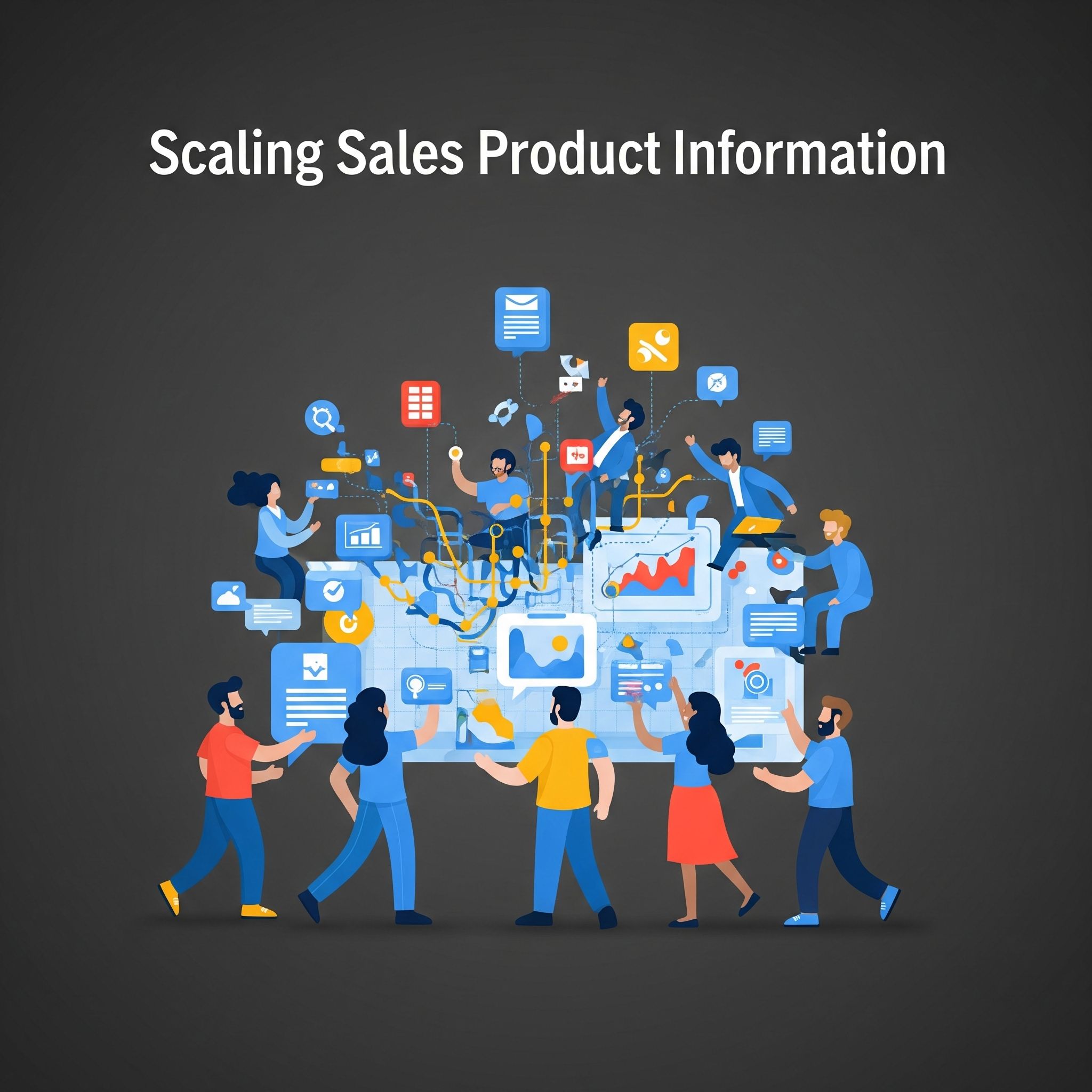PIM Scaling: How to Stop Product Data Nightmares
Tired of product information chaos? Learn how to scale your PIM strategy, boost conversions, and eliminate manual data entry. WISEPIM shows you how.

We've all been there. You confidently order a "premium leather office chair" only to receive something that more closely resembles a wobbly stool. That discrepancy, that gap between expectation and reality, is the kind of product data problem we help businesses avoid. While your data inconsistencies might not be that extreme, even minor inaccuracies can significantly impact sales and customer satisfaction.
This isn't simply about adding more product listings. It's about making the information you already possess more effective, consistent, and accessible across multiple channels. It's about transforming your product data from a potential weakness into a powerful competitive advantage. We help you equip your product data for success.
What is PIM Scaling (and Why Should You Care)?
PIM scaling goes beyond simply increasing your product catalog. It's about constructing a robust, streamlined system for managingallaspects of your product information. This allows you to:
- Expand into new marketplaces and channels with confidence and ease.
- Introduce new product lines rapidly and accurately.
- Tailor the shopping experience to individual customer preferences.
- Keep your team productive by automating repetitive tasks.
It's about expanding your product information management capabilities to handle increasing data volume, channel complexity, and overall scale, while maintaining the highest standards of quality and accuracy. Think of it like upgrading from a basic sprinkler system to a sophisticated, automated irrigation network for your entire garden. It frees you up to focus on high-value activities.
Why is Scaling Your PIM So Important?
Consider a customer searching for "organic cotton baby onesie, blue, newborn size." They encounter multiple listings for seemingly thesameproduct, each with differing descriptions, specifications, and even prices. This creates confusion, erodes trust, and likely drives the customer to a competitor.
That scenario represents lost revenue. Scaling your PIM is essential because it:
- Boosts Reach and Engagement: Comprehensive, accurate, and consistent product information empowers you to confidently list products across a wider range of platforms. This includes Amazon, eBay, Google Shopping, your own e-commerce site, and emerging social commerce channels.
- Strengthens SEO: Search engines prioritize detailed, well-structured product data. Improved data quality leads to better search rankings, increased organic traffic, and ultimately, more sales. This involves using precise, relevant keywords in product descriptions, titles, and attributes – for example, "merino wool socks, men's, crew length, black," instead of just "socks."
- Establishes Authority: Consistently delivering high-quality, detailed product content builds trust with your customers. They'll view you as a reliable source of information, fostering loyalty and repeat purchases.
- Improves Conversions: Accurate, detailed, and persuasive product information enables customers to make informed purchase decisions. No more guesswork – just clear, comprehensive descriptions that answer questions and address needs. This results in fewer returns and increased customer satisfaction.
- Optimizes Resource Allocation: A well-scaled PIM system optimizes workflows, automates repetitive tasks, and allows your team to concentrate on strategic growth initiatives. Instead of spending countless hours manually updating spreadsheets, they can focus on expanding your business.

7 Tips for Scaling Your Product Information Effectively
Scaling your PIM may feel daunting, but it doesn't have to be. With careful planning and the right tools (like WISEPIM), you can effectively manage your growing product data needs.
1. Create a PIM Style Guide (Your Data Governance Document)
This serves as the definitive guide for all your product information. Define your brand voice (is it conversational? Formal?), formatting preferences (e.g., bullet point usage), and a robust keyword strategy. This ensures consistency across all channels and significantly simplifies the scaling process.
Consider these elements:
- Brand Voice: Select a tone that accurately represents your brand. For example, WISEPIM users might prefer a friendly, slightly informal approach.
- Keyword Strategy: Develop a comprehensive list of primary and secondary keywords relevant to your products. Think from a customer's perspective: what terms would they use when searching for your offerings?
- Attribute Standards: Establish consistent guidelines for describing product attributes such as color, size, and materials. Use consistent terminology (e.g., "Midnight Blue" instead of variations like "navy" or "blue/black").
- Image Guidelines: Specify image dimensions, file formats, and naming conventions for all product imagery.
2. Repurpose Content (Maximize Efficiency)
If you have a compelling product description on your website, adapt it for other channels. Modify it for Amazon, condense it for Google Shopping ads, and create engaging social media posts from it. Repurposing existing content saves time and maintains consistent messaging across all platforms. WISEPIM's AI capabilities can assist in adapting descriptions for different channels with minimal effort.
3. Create a Content Calendar (Strategic Planning)
Avoid randomly publishing your product information. Plan your content strategically and in advance. This enables a more systematic approach to content development and ensures comprehensive coverage. A simple spreadsheet or a dedicated PIM solution (like WISEPIM) can help maintain organization.
4. Set a Consistent Schedule (Maintain Data Integrity)
Establish a regular schedule for updating product information, whether it's weekly, monthly, or quarterly. This ensures your data remains current and accurate, and it also helps with workload prioritization and management.
5. Outsource When Needed, Or...Leverage WISEPIM!
There are times when additional support is beneficial. Consider outsourcing tasks such as data entry or language translation. Alternatively, utilize WISEPIM. Our AI-powered content enrichment features can handle the demanding tasks of generating high-converting product descriptions, translating them into various languages, and optimizing them for different channels. It's like having access to a team of skilled copywriters without the associated expense.
6. Batch Create Content (Increase Productivity)
Instead of individually updating product information, group similar tasks together. For instance, use WISEPIM's bulk editor to update all your "summer dresses" with new descriptions, categories, and attributes simultaneously. This significantly reduces time investment.
7. Optimize Workflows (Streamline Processes)
Map out your entire PIM process, from initial data import to final publication. Identify any bottlenecks, redundancies, or areas for improvement. Then, streamline these workflows using automation and tools like WISEPIM. The objective is to make the process as efficient and user-friendly as possible.
Measuring PIM Scaling Success (Assessing Progress)
How can you determine if your PIM scaling initiatives are producing the desired results? Here are some key metrics to monitor:
Increased Output (Expanded Reach)
Are you listing a greater number of products across more channels? This is a fundamental indicator of progress.
Improved Efficiency (Reduced Time Investment)
How long does it take to onboard a new product or update existing information? A well-scaled PIM system should dramatically reduce these timelines. With WISEPIM, tasks that previously took hours can now be completed in minutes.
Cost Savings (Financial Benefits)
Calculate your cost per product listing or per channel. Scaling your PIM should lower these costs by automating tasks and minimizing manual errors.
Audience Growth (Increased Visibility)
Are you observing increased traffic to your product pages? Are you seeing greater engagement on social media? This suggests that your enhanced product information is connecting with your target audience.
Search Visibility (Improved Rankings)
Are your products achieving higher rankings in search results for relevant keywords? This is a direct consequence of improved SEO, powered by superior product data.
Consistent Quality (Data Integrity)
Are your product descriptions consistently accurate, informative, and engaging? Regularly review your product information to ensure it adheres to your quality standards. WISEPIM's AI capabilities help maintain consistency and prevent common errors.
Reduced Returns:
By providing more comprehensive and accurate information during the initial stages of the shopping experience, customers are less prone to purchasing incorrect items.
Conclusion: Scale Your PIM, Scale Your Success
Scaling your PIM is not simply about managing a larger volume of data; it's about realizing the full potential of your product information. It's about crafting a seamless, engaging shopping experience that transforms browsers into buyers and fosters enduring customer relationships. With WISEPIM, this process is more manageable than you might expect.
Ready to eliminate product data chaos and embrace the power of PIM scaling? Explore WISEPIM today and discover how our AI-driven platform can revolutionize your e-commerce operations.
May 31, 2025
Improve your product data quality.
Get more sales.
By Role
Popular Industries
Specialized
Don't see your industry?
WISEPIM adapts to any product catalog. Let's discuss your specific needs.
Talk to an expertExplore our complete catalog
Blog
Latest updates and articles
Changelog
See what's new and updated
Documentation
Guides and references
Tutorials
Learn how to use our tools
Industry Insights
Latest ecommerce industry data and analysis
Buyer Personas
Understanding your ecommerce customers
ROI Calculator
Calculate your ROI
Data Quality Calculator
Paste your product data and get a score
Process Tracker
Monitor and manage ongoing processes
Content Logic
Define and manage content automation rules
Data Quality Insights
Get insights on your data quality and improve it